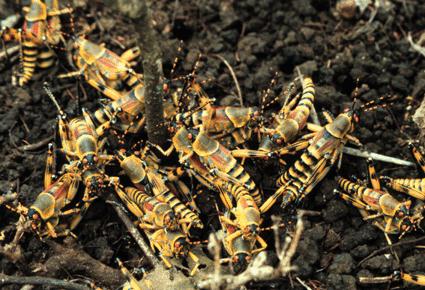
© Wickler
| Egg deposition Ei-Ablage |
back to Seibt |
| A Z. elegans female lays up to 300 eggs into the soil. We found that for egg-deposition, mated pairs form large groups on the ground, often hundreds in a dense mass. This results in mixed aggregations of unrelated tiny hatchlings which carry just a tiny amount of poison. So we suggest that many of them have to be eaten by an unexperienced predator to teach him the lesson of their conspicuous colouration. Egg-pooling by mothers then achieves a dilution advantage for their respective offsprings. | |
 |
Communal egglaying in Zonocerus elegans © Wickler |
| Newcomers find aggregations from several meters distance by visual orientation, swaying the anterior part of the body from side to side. | |
Literature
Wickler, Wolfgang & Seibt, Uta 1990: Mothers' egg-pooling and aposematic offspring's gregariousness: Cui bono? Ethology 86, 339-342
Wickler, Wolfgang & Seibt, Uta 1985: Reproductive behaviour in Zonocerus elegans (Orthoptera: Pyrgomorphidae) with special reference to nuptial gift guarding. Zeitschrift für Tierpsychologie 69, 203-223.